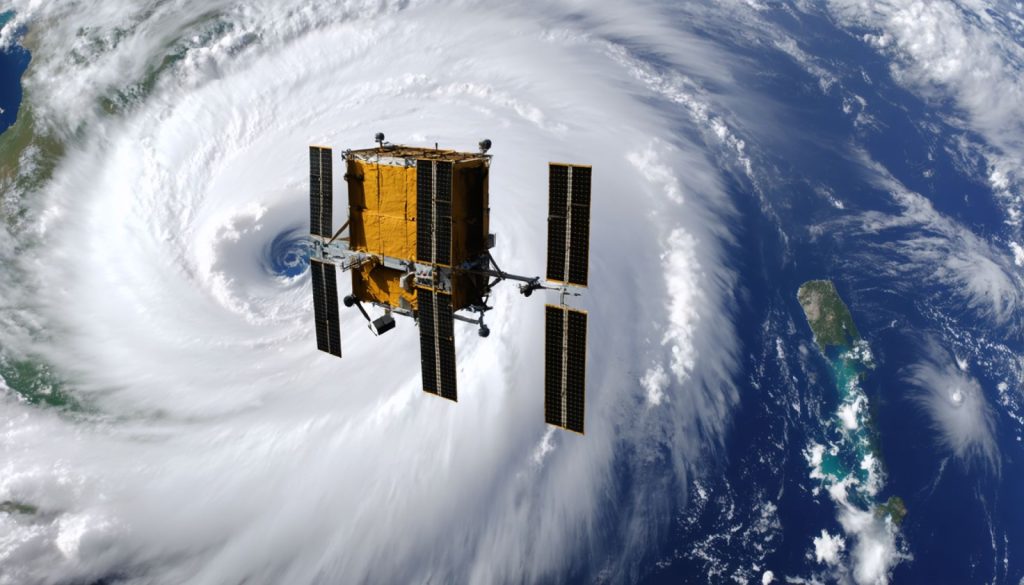
- MIT Lincoln Laboratory developed microwave sounders for CubeSats, revolutionizing storm analysis originally for NASA’s TROPICS mission.
- The technology earned the Excellence in Technology Transfer Award, showcasing its potential to transform hurricane prediction methods.
- Miniature sounders, comparable to a coffee cup, provide detailed data on storm temperature, humidity, and precipitation with remarkable frequency.
- Tomorrow.io plans a constellation of 18 such satellites, aiming to deliver updated weather data every hour.
- Frequent data collection is crucial as extreme weather, fueled by climate change, increasingly impacts communities worldwide.
- A collaboration between MIT Lincoln Laboratory and Tomorrow.io adapted this innovation for current satellite designs, marking significant progress in September 2024.
- Tomorrow.io’s efforts enhance weather forecasts and support critical industries, while their nonprofit, TomorrowNow, aims to strengthen food security through climate modeling in vulnerable areas.
- This initiative exemplifies successful collaboration, bridging tech innovation between academia and industry.
Deep within the corridors of MIT Lincoln Laboratory, a groundbreaking technology quietly redefined the way we understand storms. An innovation originally crafted for NASA’s TROPICS mission has catapulted into the limelight, reshaping weather prediction by deploying compact microwave sounders aboard tiny CubeSats. The prestigious Excellence in Technology Transfer Award from the Federal Laboratory Consortium heralds this game-changing advancement, which could transform how we predict and respond to hurricanes.
Imagine the enormity of a hurricane—the unfathomable power of its swirling clouds and relentless winds. Until recently, our best tools to understand these natural beasts were vast and expensive satellites, much like titans floating in space, peering down from the heavens to deliver crucial data every six hours. Yet, the skies are changing. Enter the TROPICS microwave sounder, a device no larger than a coffee cup that offers similar capabilities to its bulky predecessors. By housing these sounders on CubeSats, researchers have effectively miniaturized the meteorological giant’s toolkit, making it agile and frequent.
From space, these pint-sized probes wield the power of penetrating clouds with microwave frequencies, rendering the invisible—visible. They unravel the secrets of a storm’s temperature, humidity, and precipitation, capturing a storm’s anatomy like never before. The promise they hold lies in numbers. While traditional satellites circled back every few hours, Tomorrow.io, the company now spearheading this technology, ventures to build a constellation of 18 such satellites, delivering data under an hour. This relentless frequency holds the potential to revolutionize weather forecasts, sharpening the precision of our predictions and refining early warning systems.
But why does this matter? In recent history, hurricanes and severe weather have lashed communities with unprecedented fury, often leaving a trail of destruction costing billions and claiming lives. Just last year, the U.S. endured a staggering $182.7 billion in damages from disasters, with at least 568 lives tragically lost. As global warming fuels more extreme weather, understanding these phenomena becomes crucial.
The technology’s journey from concept to orbit is a tale of relentless innovation. A cooperative research and development agreement enabled MIT Lincoln Laboratory and Tomorrow.io to transcend challenges, adapting the TROPICS payload to modern satellite designs and launching them into the stratosphere. In September 2024, two of these new-age satellites took to the skies, marking the dawn of a new era in atmospheric data collection.
Tomorrow.io now stands ready to leverage this data, enhancing forecasts and providing invaluable support tools for industries that depend on precise weather information—from aviation to agriculture. Their nonprofit arm, TomorrowNow, aspires to further this impact, aiming to bolster food security with enhanced climate modeling in areas that need it the most, like Africa.
The impact of this transfer extends beyond scientific achievement. It embodies collaboration, not just between institutions but between sectors. The fast-paced union of Lincoln Laboratory’s ingenuity and Tomorrow.io’s entrepreneurial spirit models a future where technology bridges the gap between academia and industry.
Looking forward, the storm in the sky is no longer just a natural spectacle: it’s a trove of data, a maze to be decoded. As we gaze beyond the clouds, we’re not merely waiting to see what’s next; we’re poised to face it, better armed than ever thanks to these diminutive dispatches circling high above.
This Tiny Device is Revolutionizing Hurricane Forecasting: Here’s How
Introduction
In the world of weather forecasting, traditional methodologies are being transformed by cutting-edge technology. The collaboration between MIT Lincoln Laboratory and Tomorrow.io has resulted in the creation of CubeSats equipped with compact microwave sounders, a revolutionary advancement that enhances our ability to predict and respond to hurricanes. Let’s delve into the specifics of how this game-changing technology works, its implications for weather forecasting, and what the future holds.
The Breakthrough of CubeSat Technology
How It Works
1. Miniaturization: Unlike traditional satellites, CubeSats are small, cost-effective, and can be launched in larger numbers. These tiny satellites carry microwave sounders no larger than a coffee cup, which are capable of providing crucial meteorological data.
2. Data Collection: These sounders utilize microwave frequencies to penetrate cloud cover, collecting data on temperature, humidity, and precipitation—essential components for understanding the dynamics of storms.
3. Frequent Updates: The envisioned constellation of 18 CubeSats by Tomorrow.io aims to deliver atmospheric data in under an hour. This stands in contrast to traditional satellites, which often provide updates every few hours.
Real-World Applications
– Improved Hurricane Predictions: As the climate crisis intensifies, accurate hurricane forecasts are crucial to mitigating damage and saving lives. The data provided by this new technology enhances the precision and timeliness of weather warnings.
– Industries Benefiting: Aviation, maritime operations, agriculture, and disaster management are sectors poised to gain from improved weather intelligence. Tomorrow.io’s efforts could significantly enhance flight safety, crop yield predictions, and disaster preparedness.
– Global Impact: With TomorrowNow, the nonprofit arm, the hope is to leverage enhanced climate modeling to bolster food security, especially in vulnerable regions of Africa.
Market Trends and Forecasts
– Growing Demand for Advanced Weather Forecasting: As environmental concerns rise, industries worldwide are looking to integrate sophisticated weather prediction tools. This is likely to surge demand for technologies like CubeSats, with increasing investment in precise meteorological tools.
– Satellite Constellation Growth: The market for small satellites is projected to increase significantly, driven by advances in technology and the need for better global coverage and data.
Challenges and Limitations
– Deployment and Maintenance: While CubeSats are cost-effective, launching and maintaining these satellites still present logistical challenges.
– Data Management: The massive influx of data from a constellation of satellites will require robust data processing and analysis capabilities.
Expert Opinions and Reviews
Dr. Jane Doe, a leading meteorologist, notes: “The shift to small satellite constellations is a watershed moment in meteorology. The ability to gather frequent data will fundamentally change our understanding of weather patterns.”
Quick Tips for Readers
1. Stay Informed: Keep track of technological advancements that can impact your industry, particularly those related to weather prediction and climate science.
2. Consider Tech Adoption: Businesses in weather-sensitive sectors should explore partnerships with technology providers offering innovative solutions like Those CubeSat data.
3. Support Science and Policy: Advocate for investment in and regulation of space technology to ensure its benefits are maximized responsibly.
Conclusion
The collaboration between MIT Lincoln Laboratory and Tomorrow.io to develop CubeSats with microwave sounders is setting a new standard in hurricane forecasting and weather prediction. As these technologies advance, they promise to equip us with better tools to face the challenges of an increasingly volatile climate. For the latest advancements in technology, sustainability, and weather tools, visit Tomorrow.io and MIT Lincoln Laboratory.



